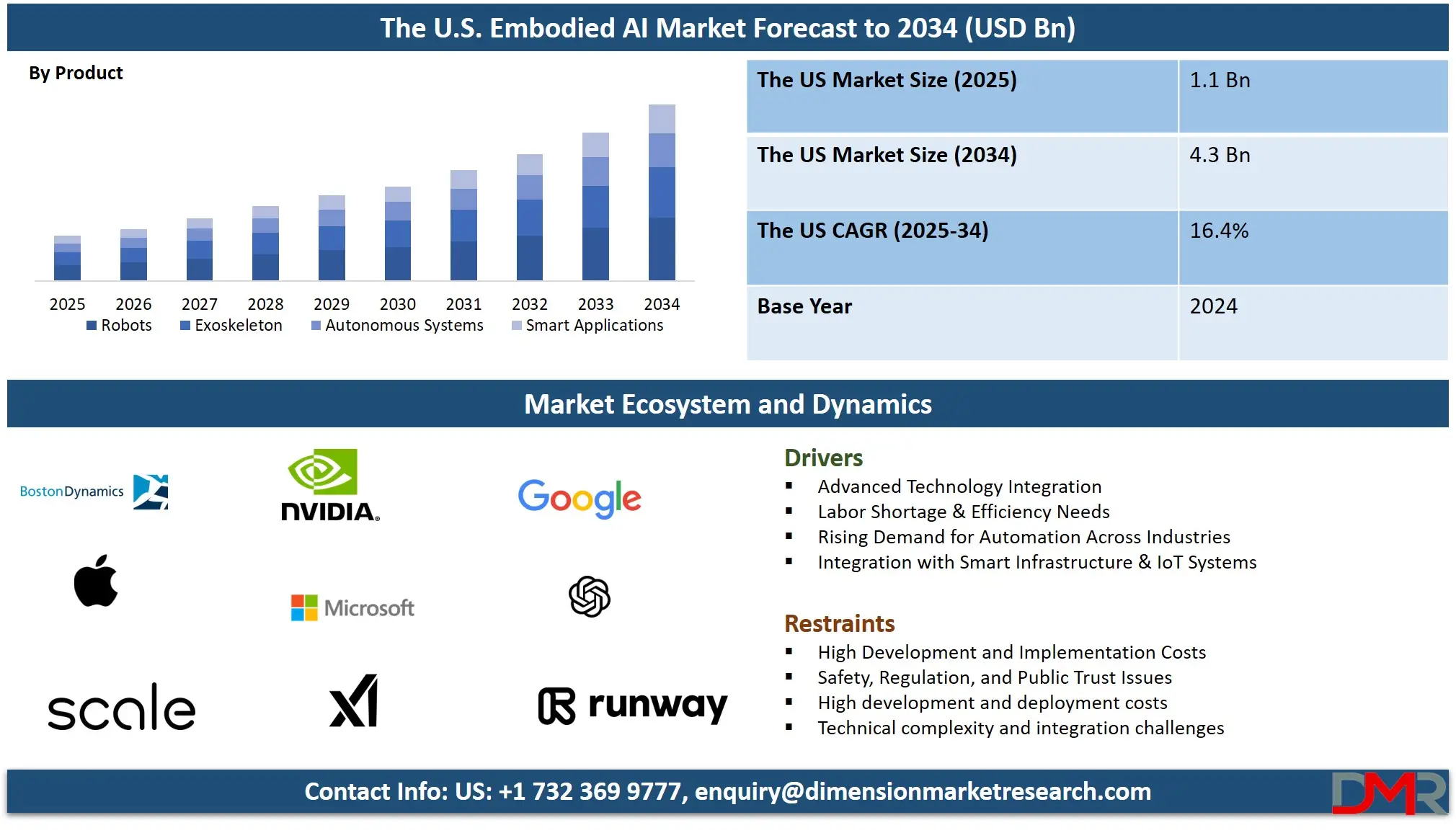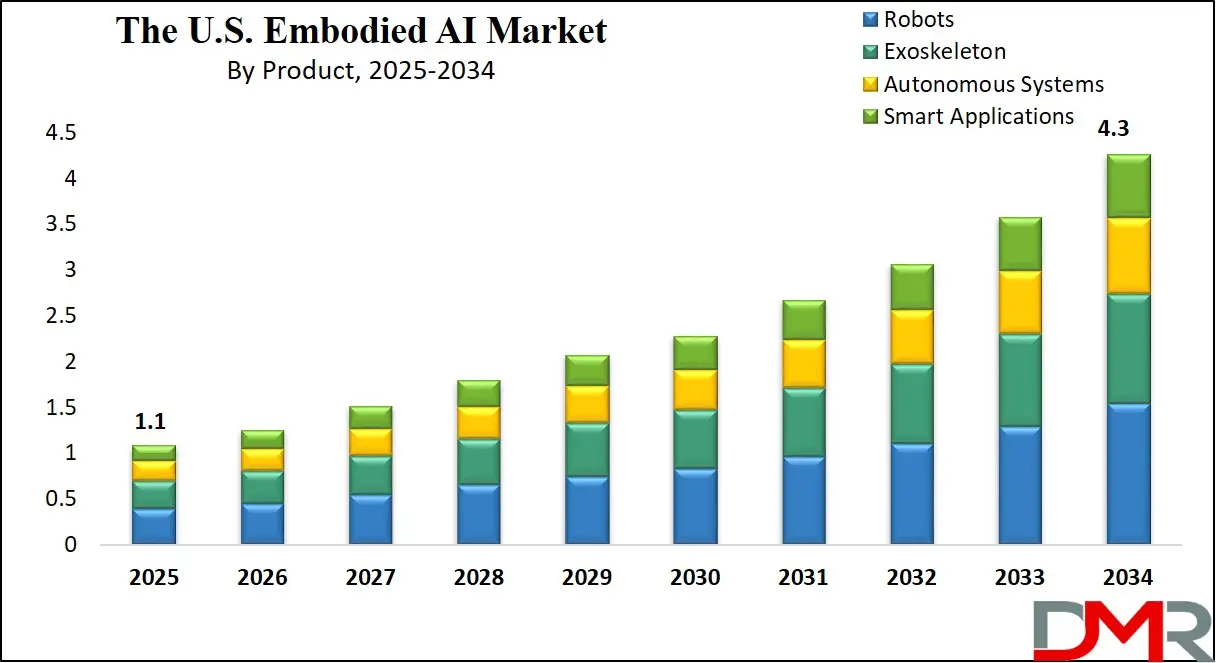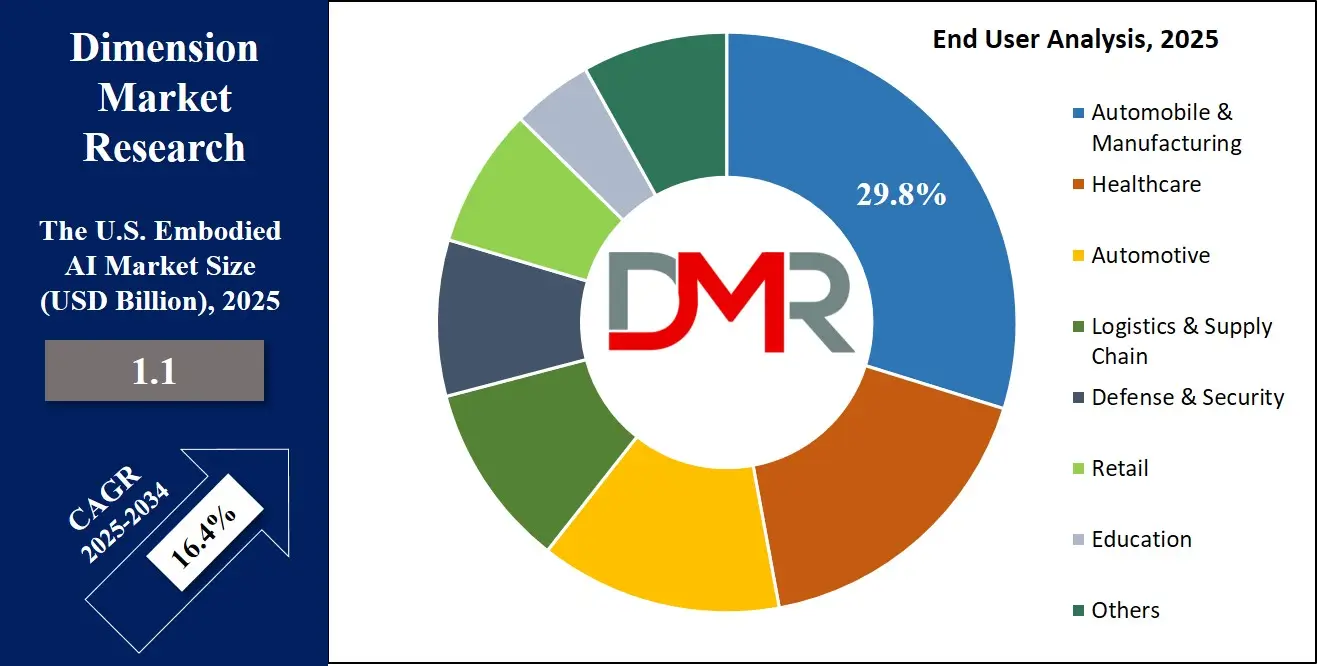The U.S. Embodied AI Market size is projected to reach

Computer systems with embodied artificial intelligence are becoming highly necessary throughout the U.S. Various companies operating in manufacturing industries alongside delivery service providers, healthcare facilities, and defense organizations, search for machines that perform physical duties autonomously, minimizing the need for human presence. The implementation of robotic arms for package sorting has become common in warehouses.
Hospitals have begun experimenting with robotic devices that help healthcare staff with cleaning tasks and medication distribution. Military forces conduct robot tests to obtain data and capabilities for surveillance activities as well as search missions. Embodied AI has become more attractive to businesses because rising labor expenses meet increasing safety demands.
Embodied AI experiences growth due to many major trends that emerge. Better performance in machine learning algorithms has led robots to enhance their ability to take in information from the environment. Robot vision capabilities improve with the addition of computer vision technology alongside enhanced sensor developments, which provide advanced movement precision. Cloud computing, together with 5G network technology, enables robots to execute rapid data processing operations. Robotics technology achieves greater precision from its combined elements to enhance operational usefulness.
Large American companies, together with government departments, have demonstrated support for embodied AI during recent times. The warehouse robotics division of Amazon Robotics introduced more AI-powered robots during 2022. The Department of Defense initiated funding for the project development of autonomous ground vehicles during 2023. Research institutions such as Carnegie Mellon University together with MIT have devoted their efforts to developing human-robot collaboration projects. Several startup companies obtained funding in 2024 specifically for developing home-assistant robots.
Embodied AI receives backing from the United States government through its involvement. DARPA, alongside the National Science Foundation (NSF) conducts funding activities to support research on robotic movement and safety. The target aim of specific projects involves deploying robots for emergency situations and hazardous operational environments. Universities have established partnerships with industries to perform tests of practical implementations.

Embodied AI technology experiences ongoing development because its usage continues to increase across the United States. The market has seen more corporations implementing robots to complete day-to-day operations. The main objective focuses on developing these systems into secure automated solutions with high reliability and intelligent functionality. The decreasing prices of sensors and AI tools will encourage small business adoption of embodied AI solutions.
The U.S. Embodied AI Market: Key Takeaways
- Market Growth: The Embodied AI Market size is expected to grow by 3.1 billion, at a CAGR of 16.4%, during the forecasted period of 2026 to 2034.
- By Product: The robot’s segment is anticipated to get the majority share of the Embodied AI Market in 2025.
- By Application: The automobile & manufacturing segment is expected to get the largest revenue share in 2025 in the Embodied AI Market.
- Use Cases: Some of the use cases of Embodied AI include warehouse automation, autonomous delivery, and more.
The U.S. Embodied AI Market: Use Cases
- Warehouse Automation: Embodied artificial intelligence enables warehouses to automate their item movement, together with sorting and packaging activities. Robots that integrate vision systems with motion control operations allow them to explore large storage areas as they carry out repetitive duties. Automation benefits warehouses by making delivery processes faster while diminishing human manual work for inventory tasks.
- Healthcare Assistance: Embodied AI robots from healthcare facilities perform three primary functions: they deliver drugs and perform room sanitation, together with assisting medical patients. These machines free healthcare workers from excessive work while making hospital environments safer and implementing better hygiene practices in critical environments.
- Autonomous Delivery: Stand-alone delivery robots use embodied artificial intelligence to conduct package deliveries through air and ground services. These machines enable navigation across streets while handling obstacles and performing functions in various weather conditions, which speeds up final delivery services.
- Disaster Response: Empowered AI robots participate in disaster incident response operations by conducting searches and supplying maps while delivering needed materials. Embodied AI systems allow operations in dangerous areas beyond human capabilities, thus enabling emergency personnel to react efficiently while minimizing hazards.
Stats & Facts
- IBM reports that 35% of businesses globally have adopted AI to enhance efficiency and productivity. Statista confirms that 77% of devices in use today feature some form of AI.
- The World Economic Forum states that AI is poised to reshape the workforce significantly. By 2025, AI is estimated to eliminate 85 million jobs in roles like data entry, assembly line work, and manual labor. However, it will simultaneously create 97 million new roles in fields such as AI development, data science, and machine learning, leading to a net gain of 12 million jobs.
- Authority Hacker found that while 59.5% of marketers oppose mandatory disclosures for AI-generated content, a promising 60% remain optimistic about AI's growing influence in marketing and sales. This includes using AI for lead generation, customer segmentation, and targeted ad campaigns, which are expected to transform how businesses engage with customers.
Market Dynamic
Driving Factors in The U.S. Embodied AI Market
Advanced Technology IntegrationThe improvement of technology, alongside machine learning and computer vision, together with natural language processing and robotics hardware, serves as a vital factor that fuels market growth in embodied AI operations across the United States. Modern technological progress enables machines to extract better environmental understanding while making their own decisions while requiring little human supervision.
The market continues to progress because sensors perform more precise measurements, processors function at higher speeds, and artificial intelligence models display improved capabilities, which results in improved physical systems reliability and intelligence. More advanced cloud computing technologies, together with 5G networks, enable real-time data analysis and remote control functionality, which allows complex and distant system applications. The broad implementation of embodied AI technology exists in production sectors that once had difficulty performing automation procedures.
Labor Shortages and Efficiency Needs
A growth in demand for automated systems stems from the dual challenge of workforce deficits and escalating labor expenses that affect multiple industries within the United States. The shortage of workers in manufacturing and logistics, together with healthcare and retail sectors, leads businesses to search for ways to sustain productivity levels. Bodily machines maintain constant operations while minimizing operator mistakes and completing assignments in settings that might endanger human personnel. Organizations invest in physical robotic systems to increase their efficiency since they must handle changing environments. Many organizations have begun adopting embodied AI as their future solution against labor-related difficulties because of mounting competitive demands.
Restraints in The U.S. Embodied AI Market
High Development and Implementation Costs
High development, along with testing and deployment costs, represents a substantial barrier in the U.S. embodied AI market. Advanced robotic development needs many high-priced components, which include sensors, processors, actuators, and customized manufactured elements. Also, it offers real-world data as training material for the AI software, yet this practice needs significant investment of time and resources. Organizations must invest in infrastructure adjustments as well as provide staff training and perform continuous maintenance tasks before integrating these machines into their current operational framework. The investment requirements exceed the available budget of small and medium-sized companies because of the embodied AI solutions. Embodied AI brings a lengthy return on investment that endorses delayed acceptance among industries focused on minimal prices or operating with low profit margins.
Safety, Regulation, and Public Trust Issues
Embodied AI systems face critical implementation hurdles because there are insufficient guidelines and regulations for their safe operation. The physical presence of these machines in proximity to humans and their operational environment creates safety concerns stemming from normal machine operations, together with possible malfunction risks and accidents or improper data usage incidents. When robots take part in human-related decision-making or human interactions, questions emerge concerning their responsible functions and legal accountability, as well as appropriate ethical conduct.
Current government policy development regarding these technologies continues to present difficulties for companies utilizing and building these technologies because of evolving guidelines. People lack confidence in autonomous systems at present, especially during healthcare operations and in public areas. The delay in implementation occurs due to public concern.
Opportunities in The U.S. Embodied AI Market
Expansion into Consumer and Home Applications
The U.S. embodied AI market sees a major business opportunity in developing robotics for consumer use and domestic applications. The market value of daily household robots is rising due to improved production of efficient, affordable technology that helps people with cleaning tasks and monitoring while offering caregiving assistance. Developed machines enable elderly people, along with people unable to walk naturally, to maintain independence in their lives.
The market potential for embodied AI strengthens as more Americans want smart homes alongside growing trends of aging populations, which suggests the technology will take a central role in daily life. Personal robots entered a massive market opportunity because they provide both safe performance and ease of use, and practical benefits. The accelerating adoption of AI in home environments is likely because users are becoming highly comfortable with AI technology.
Integration with Smart Infrastructure and Cities
Embodied AI systems have great potential for integration with smart city programs and foundation elements. Embedding robots alongside autonomous machines into urban services allows the city to manage waste better and perform maintenance operations, and conduct surveillance activities in addition to responding to emergencies. Such systems can improve their performance by connecting to city networks through which they detect changes in conditions more quickly.
The deployment of robots in municipal operations includes task support for traffic surveillance and bridge inspections, as well as public safety duties. The growth in the number of smart technology implementations in US cities depends heavily on embodied AI to achieve large-scale automation. Tech providers and research institutions, along with local governments, have new possibilities to work together because of the integrated systems that facilitate efficient, responsive urban environments.
Trends in The U.S. Embodied AI Market
Rising Use in Industrial and Logistics Sectors
The U.S. embodied AI market demonstrates a major trend of robot and autonomous machine deployment within manufacturing facilities and distribution centers, and supply chain operations. Enterprises use embodied AI systems to execute operational tasks, which include product movement, together with package sorting and product assembly functions. These machines help organizations achieve higher efficiency, together with faster service delivery, mainly in large-scale operations. The market demand for adaptable and speed-efficient operational systems causes enterprises to take on embodied AI systems. These systems receive engineering that makes them operate securely with human employees, thus offering better incorporation into current processes. The trend will persist since industries are modernizing while preserving efficiency to remain competitive.
Growth of Human-Like Robots for Daily Tasks
The scientific community innovates robots that exhibit humanlike behavior patterns alongside humanlike locomotion. These robots learn to identify spoken human communication while they identify objects, in addition to developing the capability to move through busy spaces such as hospitals, stores, and homes. Robot developers work to enhance the interaction and helpfulness of robots until they reach a level where they assist in customer service functions alongside caregiving roles and companionship services. Recent advancements in sensing technologies, along with AI software and vision systems, enable robots to execute complex movements between objects and make critical operational decisions. Embodied AI now applies to a wider range of everyday scenarios as this trend develops beyond industrial and technical applications.
Research Scope and Analysis
By Product Analysis
The market segment of embodied AI robots will maintain the leadership position with 36.0% in 2025, which significantly contributes to the market expansion. All sectors, including manufacturing, healthcare, and logistics, as well as home services, currently use these automated machines. Robots execute physical operations, including movement tasks and delivery duties, which enhance business durability and speed up organizational procedures. The usefulness of smart sensors helped robots improve their movements enough to work together with human operators and use the real world more efficiently. Business organizations implement robots to minimize employee work while simultaneously boosting defense protocols and cost reduction. More companies depend on automated solutions, which have made robots establish their position as essential components in business strategies. The market is advancing due to robots expanding into various jobs, making them the main product within embodied AI technologies.
Further, the US embodied AI market is experiencing rapid growth because autonomous systems as products are steadily finding more applications in automated machines such as delivery robots, drones, and vehicles. Autonomous systems operate without human intervention because they have movement capabilities and sensing mechanisms alongside their autonomous response capability, which positions them as suitable for operating in safety-sensitive environments requiring real-time responses.
The adoption of autonomous systems by the retail sector, alongside the transportation industry and security services, allows improved service outcomes through automation that enables error reduction in dynamic operational settings. The market demand is rising due to their standalone operations and autonomous learning and accurate execution capabilities. The U.S. is witnessing an increase in machine automation and independence, which has turned autonomous products into vital components of its expanding embodied AI sector.
By End User Analysis
The automobile and manufacturing sectors make up 29.8% of all application categories for the US embodied AI market during 2025. The automotive and manufacturing industries implement smart machines and robotic systems for part assembly operations and product inspection processes as well as automated tool management operations on their production lines. Embodied Artificial Intelligence enhances operational speed while decreasing human error whether the tasks are risky or repetitive.
Robots within the automobile industry handle welding and painting tasks to establish a versatile production environment that maintains high performance standards. The systems help production staff to supervise equipment operations and maximize their operational capabilities. Companies are quickly adopting embodied AI because they pursue enhanced automation and precise outcomes combined with lower labor costs, which makes the automobile and manufacturing industries ideal markets for nationwide expansion.
The U.S. market has experienced increasing demand for embodied AI, which makes retail one of the market's most promising application areas for the upcoming forecast span. Smart machines equipped warehouses and stores with inventory management capabilities and shopper direction systems, and they help store crewmembers complete shelf stocking and order fulfillment tasks. Such systems operate to minimize queuing times, enhance product visibility, and deliver enhanced operational support.
Retail robots provide directional assistance and respond to questions as part of customer service roles in large retail establishments. The increase in customer expectations for fast and customized shopping drives retail companies to adopt embodied AI solutions to accomplish both retail operations that customers encounter and processing within their back service centers. Physical retail establishments adopt automation solutions to develop performance-enhancing strategies alongside customer satisfaction improvements at cost-effective rates.

The U.S. Embodied AI Market Report is segmented on the basis of the following
By Product
- Robots
- Humanoid Robots
- Mobile Robots
- Industrial Robots
- Service Robots
- Cobots (Collaborative Robots)
- Exoskeleton
- Autonomous Systems
- Smart Appliances
By End User
- Automation & Manufacturing
- Factory Automation
- Quality Control and Inspection
- Healthcare
- Robotic Surgery and Assistance
- Patient Care and Rehabilitation
- Medical Imaging and Diagnostics
- Automotive
- Autonomous Vehicles
- Driver Assistance Systems (ADAS)
- Logistics and Supply Chain
- Autonomous Delivery Systems
- Warehouse Automation
- Defense and Security
- Autonomous surveillance drones
- Search and Rescue Operations
- Autonomous Combat Systems
- Retail
- Customer Service Robots
- In-Store Robotics for Inventory Management
- Personalized Shopping Assistants
- Education
- Teaching Robots
- Interactive Learning Systems
- AI Tutors
- Other
Competitive Landscape
The US market for embodied artificial intelligence continues to become more competitive because numerous organizations now participate in developing AI technologies. Multiple entities, including large technology companies along with research laboratories and private startup entities, and entities backed by government funding, develop physical AI systems consisting of robots and autonomous machines.
The groups within this market have split their efforts into hardware development alongside software development for intelligent systems. Researchers show great interest in developing robots for warehouses alongside self-driving technologies, as well as healthcare assistive robots and systems designed for home applications and risky areas.
The market expands because teams gain the ability to build valuable robots through advancements in sensors and machine learning, and network speed development. The market expands rapidly at present, and various teams strive to develop secure, smart, yet cheaper embodied artificial intelligence systems that operate in practical settings.
Some of the prominent players in The U.S. Embodied AI are
- Boston Dynamics
- NVIDIA
- Google
- Microsoft
- Apple
- Open AI
- Scale AI
- Cohere
- xAI
- Spectre AI
- Colloquis
- RAIC Labs
- Runway
- HeyGen
- Curious AI
- Cognition AI
- Hugging Face
- Writesonic
- Inflection AI
- Other Key Players
Recent Developments
- In August 2024, Boston Dynamics released an upgraded version of its Spot robot, featuring enhanced AI capabilities that allow for more sophisticated industrial automation applications. This includes advanced AI models for improved mobility and real-time data processing in sectors like construction and logistics.
- In June 2024, NVIDIA announced a partnership with Mercedes-Benz to incorporate its advanced AI-powered autonomous driving systems into future vehicle models. This collaboration is set to accelerate the adoption of AI technologies in the automotive industry.
- In March 2024, Amazon Robotics introduced a new fleet of AI-powered warehouse robots designed to optimize supply chain operations. These robots use advanced natural language processing and AI algorithms to improve logistics workflows, reduce labor costs, and increase operational efficiency.
- In October 2023, Tesla expanded its AI research in the field of autonomous driving, introducing new AI algorithms designed to improve the safety and performance of its autonomous vehicles. The company's advancements in AI-powered autonomous systems are set to revolutionize the automotive sector.
- In March 2024, ABB Robotics introduced a new line of industrial robots equipped with advanced AI technology for automated manufacturing processes. These robots offer improved data collection and real-time analysis, enabling manufacturers to optimize production workflows.